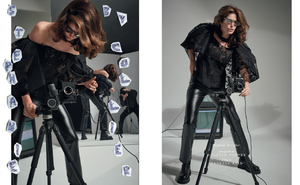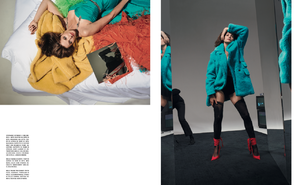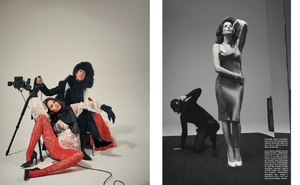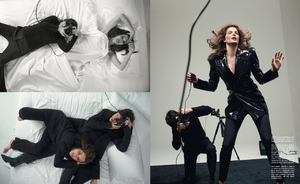Stephanie by Stephanie
What do we see in Stephanie Seymour? For one, a mystery. All great beauties are. They can hold our gaze in a way that asks us to look deeper, to uncover more and more layers, as if they were ours to see. But Seymour is not like other great beauties. After all, she is one of the greatest beauties, a member of a caste so élite its members—Cindy, Linda, Claudia, Christy, Naomi—required an entire new category: the Supers. It was these supermodels, and in the 90s they were superstars, to whom waking up for less than $10,000, as Linda Evangelista famously joked, was not an option (the equivalent today might be 100,000 likes, which is to say there is none).
And yet Seymour’s mystery is more profound, more powerful. She’s covered more than 300 magazines and yet we know only the sparest details about her. We know she was discovered at 15, when she entered modeling agency Elite’s Look of the Year competition, and was soon in New York, dating that company’s founder, John Casablancas. Her past is less of a model than a cipher for 1980s and 90s glamour, media and art. Her unmatched figure and all-American pout beyond pout went on to inspire Richard Avedon—who called her body “perfect”—and serve as muse to Azzedine Alaïa, while she booked million-dollar deals with Victoria’s Secret and L’Oréal. She turned things on their heads, making her way through Warren Beatty and breaking the heart of Axl Rose—the last living rock god—before ending up with billionaire art collector and financier Peter Brant, which whom she has 3 children. Even when things have gone south (she and Brant looked to divorce in 2009 and she was arrested for a DUI in 2016), the mystery stays shrouded: she and Brant reconciled with the year; the DUI was removed from her record. She acts less like a fashionista than fashion royalty—above it all, and yet human—which has driven the press insane. When paparazzi pictures of she and her son being affectionate on a beach became public, newspapers and websites fed on them for what felt like years. Seymour didn’t blink. In an age of oversharing, where personalities and personal branding are often indecipherable, Seymour is not so much an oddity as a revelation. Something totally unique. In a world when everyone wants you to know them, Stephanie is known not to care. The harder we look, the more interesting question isn’t so much what we see, but what she does.
Here, she looks into a mirror—past the image—and reflects on both the work and the life she has made. She tells Vogue Italia about Helmut Newton’s fake nipples, Avedon’s rage, the responsibility of motherhood, and her path from girl to woman (as well as the secrets she and Naomi can never tell). As Seymour looks deeper into the mirror, she reveals that it’s a trap, both full of endless possibility and equally bottomless pitfalls. She considers her reflection—she cannot escape it—but she also moves through it, embracing herself as a mother, friend, wife and business owner. Seymour shows us a woman. And then she goes off to tend her garden.
You are someone who is famously seen. We’re asking you to look at yourself in this shoot. Tell me what you see.
I see a mother. I see a wife. I see all of the things I need to get done in a day. I see all of my responsibility. As you get older, you have a lot more responsibility as a woman. Taking charge of your life is really important. I try to think about not myself but the people I need to take care of, my children, my friends, my company, my husband. I am never one to think the world revolves around me.
That’s becoming so rare in our culture. I think about the selfie. Do you take them?
I don’t. It is fun to do selfies with your friends. But I am not sort of able to continue this sort of idea of self-promotion. I believe that was already done with my work. I prefer to let the work stand on its own.
What it was like to be discovered so young? You were a kid.
I sent my picture in to the Look of the Year and within a year and a half—I left school, I left my family, I left everything behind—I moved to New York. I was about 15. I didn’t really understand what I was doing, but my life completely changed. I think it was a really wonderful thing, and I think I was very blessed.
It was a lot of hard work. You had to work really hard at that time to get yourself noticed. You had to create a pretty thick skin for yourself. You had to learn that things were rarely going to go your way. People were going to promise you a lot of things. It teaches you a lot.
In the beginning, I was sort of a clothes hanger. I was really not included. I was whatever anybody needed me to be. After about 20 years, I really got it. I became inspired. And I really felt that it was a collaboration—great stylists, great hairdressers, great photographers, great models—all of us together creating beautiful images. When we were lucky. I made really good friends.
Like who?
All the girls, we always took care of each other. I always had difficulty doing shows. I can remember having horrible anxiety attacks backstage at the Dolce & Gabbana show in Milan. I was 19. I had lashes on and all kinds of make-up. I started crying. This was a period of time where all of the big girls did their own make-up. Linda and Naomi and Karen; they had their make-up boxes.Linda was really sweet. She took all of my make-up off and redid it. Linda is the best make-up artist of all.
As you became more well known, and then famous, did how you see yourself begin to change?
When models hit a period where they are very successful, they are still only a few years off from being a little girl and under the wing of your family. It is not really about what you see in the mirror. Nobody sees reality in the mirror. What you see in the mirror has nothing to do with who you are as a person. I think most of the girls who handled success well had strong families. I wanted to make my family proud. I wanted to make myself proud.
In general, I don’t think beautiful girls look in the mirror and think they are beautiful. They probably think the opposite. It is a shame. There’s that constant idea that what you look like is more important. But it isn’t what you look like, it’s who you are inside.
What was it like to shoot with Helmut Newton?
He had such a great sense of humor. And such a great eye for this restricted kind of dark sensual beauty. It was really interesting. He had these big rubber nipples. He liked to put them under the girls’ blouses so you would look like you had big hard nipples. I know that is really gross, but Helmut had it down to a science. He would come in with his glasses, and he would have you put them in your bra. It all seemed kind of bizarre. I don’t know if it entertained him or it really worked in the pictures, but I learned never to question the director. Some photographers you should question. But I would never, ever question him.
Even in the most sensual, dramatic pictures, there is often some kind of humor, something a schoolboy would laugh at.
My first job with him, we shot all day and at the end of the day, he said, “I’m taking some pictures of topless girls ironing. And I wondered if you could do a picture for me ironing?” The hairdresser put my hair in little braids, like the little German girls like he liked. I was in a little housekeeper’s outfit, but without a top. I was supposed to be ironing in the basement of this chateau. I said at the time, “Let’s take these pictures but you can’t use them without my permission.” By the time he got around to using them, I asked him not. He was so angry at me, so mad at me.
What is it like when Helmut Newton is mad at you?
It was horrible, devastating, to have him mad at you. What is it like when Avedon is mad at you? Ask me about that. He knew when to put you in a corner. He was gifted at controlling people, and he was a great director. I learned so much: I learned how to set my gaze. How to create intention in my eyes. I learned how to fall, how to jump. I may have thought I knew how to do those things before, but it was like going to school. Dick was a master of all of these things. He was a great model himself. He would show you exactly what to do. He could do it all. He would show you where to put your weight.
Almost like a choreographer.
Oh, he was a choreographer. And he did have choreographers come in and work with us from time to time: “Okay, I know your instinct is to put your weight on your right foot but put it on your left and raise your right arm.” Interesting things to change the movement of the photograph. He made you so important.
He taught me what the word collaboration really meant. Only once I had someone really treat me like that, a great artist, pull me in. He would allow me to sit and help him edit photographs from the day before. He would call me in and say, “Let’s do this together. Help me.” He might say, “I don’t like any of these. Look at them and agree with me that we have to reshoot.” And I would think, we just spent six hours shooting. But I had to agree that he was always right. It was a gift to have someone like that put energy and interest into me.
I wonder when you look at the fashion landscape now, do you see anyone working on a similar level?
I don’t think I could really say. I would love to see more of what is going on. I know that my son Harry is really excited about the shoot we are doing for Italian Vogue. I kind of defer to the younger people now.
Tell me how you got to know Gianni Versace.
Before Gianni, there used to be show models and fashion models. They were a completely different set of girls. Gianni loved the girls who did the shows but wanted the other girls too. Linda, Naomi, this girl, that girl. I never made myself available to do shows because they made me very nervous. He wasn’t going to take no for an answer. He called my agency, offered me a lot of money to do a show. When my agent told me, I said, “He knows I don’t do shows, right?”
I had a relationship with Versace I didn’t have with anyone else. I would go to Milan to do Versace, but I didn’t do any other shows. They always knew how to take care of the girls way beyond anyone else. All of a sudden, you were in the best hotel. I already had my son Dylan, and I would arrive to flowers in the room and toys for him. A car to pick me up and take me to work every day, wait for me outside, and take me home. You were taken into someone’s arms. You were under the Versace wing.
And working with Versace altered your career path.
Versace always worked with the best people. Avedon did all of their campaigns. I started doing a lot of the campaigns with Dick. Nobody did campaigns like that. They were incredible. There were no rules. Gianni would say “Whatever you want to do, Dick. That’s fine.” They would talk on the phone every morning. He’d send them the pictures from the day before. Gianni knew how to get everyone to come in and keep everyone close. That’s a very special thing.
What was your personal relationship?
He was always all about work until he fell in love. Everything changed. He started collecting art. He smiled more. And then he was taken from us, and that was such a tragedy. The last couple of times I saw him, I couldn’t believe how happy he was.
That time of the Supers and Versace--do you have a favorite memory, something you might kick around at a cocktail party?
I never kick anything around at a cocktail party. I’m very guarded about my life. I have a lot of good memories, and they are probably all with Naomi. We went through our teens, twenties and thirties together. I wish I could get into detail. Certain people would never forgive me.
How have you evolved since then, as a person, as a woman?
I started modeling when I was 15 and I’m 51 now. If I haven’t had a multitude of evolutions over these years, there would be something wrong with me. I am always trying to be a better person. Can I learn more? Can I be a better mother? Can I be a better friend? Can I be a better wife? The evolution is very complex. Things happen. They change you, but you really end up coming back to your core values and striving for those same things over and over and over again.
What about physically—how has the relationship with your own body changed?
I’m accepting. I can accept that I don’t look the same, that my body is not the same. I don’t always like what is looking back at me, that I’m older or heavier. I try to keep a mantra going. The mantra is that keeping your mind active and busy is much more important than looking at yourself in the mirror and picking on yourself. Women look beautiful at every age of their life. I try not to get caught up in what I used to look like or what girls look like now. If I put more of my focus on things that make me feel good, gardening—I am growing a lot of lavender and tomatoes—or designing my line, spending time with my children, it’s a very different life.
Your lingerie line, Raven & Sparrow, is a celebration of women’s bodies. You’ve said that it challenges the idea of lingerie being made for men.
Exactly. You would go around and look for lingerie and a lot of what you find is really more what an old woman wants to sleep in, or what men would like. There was nothing in between. Men want things that are completely not reasonable: the garter belts and stockings, totally uncomfortable to wear out or to sleep in. Men actually like a lot more than they know they like. I like to push these things on men. It’s like when a girl wears an oversized t-shirt, the morning after, how sexy that is. Who would sell that? I would sell that. But we are specializing in is sleepwear, nightgowns, peignoirs, loungewear.
It is more about what we like to call the ritual of dressing for bed. I like to go to sleep in something that makes me feel good so that when I wake up in the morning, I feel good about that too.
That idea of feeling good when you see yourself, it makes me think of my first question, of what you see in the mirror. After all this reflection on your career, on your life, can you look in the mirror and tell me what you see?
A woman, not a girl anymore. Only a woman can know what that means. It does accompany a lot. It is pretty heavy stuff, but I’ve actually had to take that burden on. I look in the mirror and say, “Alright now, let’s get through another day. You are a woman now. You can do this.”





